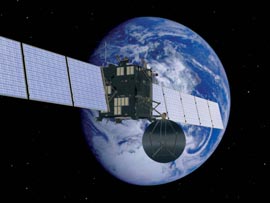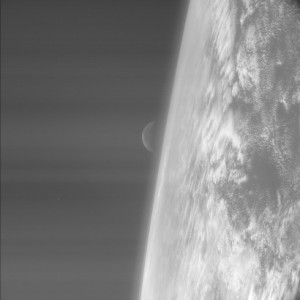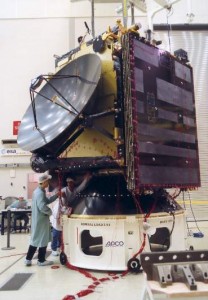Rosetta

Source: ESA
Rosetta is the first mission which will escort a comet from almost aphelion to perhelion and beyond. The ESA spacecraft was launched on 2nd May 2004 by a Ariane-V rocket for a ten year circuit until arrival at 67P/Churyumov-Gerasimenko in 2014. Rosetta used several flybys at Earth and Mars to gain momentum.
Am 2. März 2004 startete die ESA-Raumsonde ihre zehnjährige Reise zum Kometen Churyumov-Gerasimenko mit einer Ariane-5 Rakete von Kourou, Französisch-Guayana. Bis zu ihrer Ankunft im Jahr 2014 wird Rosetta mehrere Vorbeiflüge an Erde und Mars nutzen (sog. „swing-bys“), um genügend Schwung zum Erreichen des Kometen zu holen. Es besteht das Ziel, den Kometen Churyumov-Gerasimenko ganz aus der Nähe zu studieren, ihn für viele Monate zu umkreisen und schließlich mit einem Lander auf der Kometenoberfläche zu landen. Da sich der Komet während dieser Zeit immer näher auf die Sonne zubewegt, wird es somit erstmalig möglich sein, die Veränderungen des Kometen bei seiner Reise über mehrere Millionen Kilometer durch das All zu untersuchen. Darüber hinaus wird Rosetta auf ihrem Weg in das äußere Sonnensystem zwei Asteroiden, Steins und Lutetia, mit Hilfe von nahen Vorbeiflügen wissenschaftlich untersuchen.
Why fly to a comet?
Die Entstehung des Sonnensystems ist in vielerlei Hinsicht ungeklärt. Daher werden die Ursprünge von Kometen und die Beziehung zwischen Kometen und interstellarer Materie erforscht, was wiederum Rückschlüsse auf die Entstehung des Sonnensystems zulässt. Da Kometenkerne nur wenige Kilometer groß sind und im Wesentlichen aus Eis und Staub bestehen, werden sie häufig als „schmutzige Schneebälle“ bezeichnet.
The origin of the long periodic comets is the so called Oort cloud, which is arranged spherical in a distance of approx one light year around the sun. The short periodic comets (which orbit faster and with shorter periods around the sun) presumably originate from the Kuiper belt, which is a flat and discoidal region beyond Pluto. There they reside to some extend in a manner of cosmic freezer due to the large distance to the sun and hence consist of the primary material from which our Solar System developed some 4,6 billion years ago.
| Diameter of nucleus - estimated (km) | 3 x 5 |
| Rotation period (hours) | ~ 12,7 |
| Orbital period (years) | 6,45 |
| Perihelion distance from Sun (million km) | 186.0 (1.243 AU*) |
| Arphelion distance from Sun (million km) | 849.7 (5.68 AU*) |
| Orbital eccentricity | 0,64 |
| Orbital inclination (degrees) | 7,04 |
| Year of discovery | 1969 |
| Discoverers | Klim Churyumov & Svetlana Gerasimenko |
*AU = astronomical unit (mean distance between Earth and Sun, approx. 150 million km)
Steins and Lutetia
After the successful launching of Rosetta the decision of the flybys past the asteroids Steins and Lutetia was finally fixed on the 11th of March 2004. The asteroids reside in the asteroid belt between the orbits of Mars and Jupiter. The visit of an asteroid or more is part of the scientific aims of the mission since its beginning.
Asteroids are primitive bricks of the Solar System from the time when it formed some 4,6 billion years ago. They vary in size (some to 100 km) and composition and until now only a few could be investigated at close range.
Die für Rosetta ausgewählten Zielasteroiden Steins und Lutetia haben recht unterschiedliche Eigenschaften. Steins, mit einem Durchmesser von nur wenigen Kilometern ein vergleichsweise kleines Objekt, soll von Rosetta am 5. September 2008 aus etwa 1700 km Entfernung beobachtet werden. Diese „Begegnung“ wird bei der relativ geringen Geschwindigkeit von etwa 9 km/s während Rosettas ersten Ausflugs in den Asteroidengürtel stattfinden.
Der zweite Asteroid, Lutetia, ist weitaus größer: Er hat einen Durchmesser von rund 100 km. Ihn wird Rosetta am 10. Juli 2010 während ihres zweiten Flugs durch den Asteroidengürtel mit einer Vorbeifluggeschwindigkeit von 15 km/s aus rund 3000 km Entfernung beobachten.
Die Sonde dürfte bei ihren Vorbeiflügen an diesen Urzeit-Felsen spektakuläre Bilder aufnehmen. Ihre Bordinstrumente werden Aufschluss über Masse und Dichte der beiden Asteroiden geben und uns somit mehr über ihre Zusammensetzung verraten. Rosetta soll außerdem die Temperatur unter ihrer Oberfläche messen und nach Gas und Staub in ihrer Umgebung Ausschau halten.
Scientific aims of the Radio Science Investigations Experiment (RSI) at the comet Churyumov – Gerasimenko
‚Schwerefeldmessungen an einem Kometen‘
- Determination of mass and mean density
- Moments of inertia of the comet
- Precise determination of the comets orbit
‚Untersuchung der Kometenkoma‘
- Electron content
- Gas and dust production rates
- Amount of dust with grain size cm – dm
- Mass flow to the spacecraft
‚Untersuchung des Kometenkerns (bistatic radar)‘
- Size and shape
- Structure and roughness of the surface
- Rotation, precession and nutation rates of the comet nucleus
Rosetta – Data
| Mission | |
|---|---|
| Launch | 2nd March 2004, 08:17 am MEZ |
| Launch site | Kourou, French Guayana |
| Launcher rocket | ARIANE 5 G |
| Duration of the mission | In total 12 years, until December 2015 |
| Mission Control Center | European Space Operations Center (ESOC), Darmstadt |
| Philae Lander Control Center | DLR MUSC, Cologne |
| ground stations | Perth (Australia), Kourou (French Guayana) |
| Start weight | 3,000 kg |
| Fuel | 1,670 kg |
| Scientific payload | 165 kg |
| Orbiter | |
|---|---|
| Dimensions orbiter | 2.8 m x 2.1 m x 2.0 m |
| Dimensions solar cell | 2 pieces, each with 14 m length, with a total plain of 64 sqm |
| Energy supply / Energy production of the solar cells | 850 W at 3,4 AU*, 395 W at 5,25 AU* |
| Communication antenna | High gain antenna, 2,2 m diameter, rotatable |
| *AU = astronomical unit (mean distance between Earth and Sun, approx. 150 million km) | |
| Philae-Lander | |
|---|---|
| Weight | 100 kg |
| Data transfer | 16 kilobytes per second via orbiter |
| Energy supply | Solar generator, 4 W, primary (for the first 60 hours after landing on the comet) and secondary (rechargeable) batteries |
| Time schedule | |
|---|---|
| Launch | March 2004 |
| 1st Earth flyby | March 2005 |
| Mars flyby | March 2007 |
| 2nd Earth flyby | November 2007 |
| 3rd Earth flyby | November 2009 |
| Rendezvous maneuver | May 2014 |
| Global mapping of the comet | August 2014 |
| Landing on the comet | November 2014 |
| Orbit flight | August 2015 |
| End of the mission | December 2015 |
Meeting with the comet

Source: ESA
The most difficult phase will be the meeting with the fast moving comet Churyumov-Gerasimenko. In May 2014 Rosetta should reach an orbit around the planet. Churyumov-Gerasimenko is a short periodic comet which recurs every 6,57 years. It was discovered in 1969 by Klim Churyumov (University of Kiev, Ukraine) and Svetlana Gerasimenko (Insitute of Astophysics Dushanbe, Tajikistan). Two approaches to Jupiter in 1840 and 1959 changed the comets orbit from initially 4,0 AU perihelion distance to 1,28 AU. It belongs to comets of the so called Jupiter family (with the aphelion, i.e. the most distant point, at the Jupiter orbit) which is a group of short periodic comets in the Solar System.
Rosetta wird Churyumov-Gerasimenko auf seiner Bahn folgen und im Jahre 2014 treffen. Das Rendezvous soll in einer Entfernung vom 4,8 AE von der Sonne entfernt stattfinden und im Mai 2014 wird Rosetta sich in einen Orbit um den Kometen begeben und ihn für 17 Monate begleiten. Da von Churyumov-Gerasimenko nur sehr wenig bekannt ist, und weder gesicherte Erkenntnisse über seine Größe, seine Form noch seine Masse vorliegen, wird der Anflug an den Kometen recht schwierig sein. Nach Auswahl eines geeigneten Landeplatzes, einen Monat nach Beginn der Kartierung Churyumov-Gerasimenkos in ungefähr 3.25 AE Abstand von der Sonne, wird der Orbiter ein 100 kg schweres Landemodul (Philae-Lander) auf der Oberfläche absetzen. Wegen der sehr geringen Gravitation muss die Landegeschwindigkeit sehr niedrig sein, kleiner als 1 m/sec, sonst würde der ‚Lander‘ vom Kometen abprallen und ins All verschwinden. Gleichzeitig wird die Raumsonde den Kometenkern weiterhin umkreisen und seine Veränderungen über mehr als 14 Monate verfolgen. Zu dieser Zeit wird der Einfluss der Sonne begonnen haben, Teile des Kometenkerns zu verdampfen und die Oberfläche des Kometen wird ausgasen. Hierbei kann erstmalig beobachtet werden, wie sich ein Komet bei der Annäherung, bei seiner geringsten Distanz (Perihelion-Passage) und bei der Entfernung von der Sonne verhält und verändert.
Primary objectives of the Rosetta mission:
- Investigation of the origin of the Solar System through the investigation of the composition of a comet
- The exploration of the interaction between comet material and interstellar material
- Global characterization of the comet nucleus (dynamical properties, surface morphology, composition)
- Chemical, mineralogical and isotopical composition of the volatile and solid substances of the comet nucleus
- Physical properties and correlation between the volatile and solid substances of the comet nucleus
- Investigation of the evolution of the comet activity and the processes in the crust of the nucleus and the inner coma (dust/gas interaction)

- Investigation of the general characteristics of the asteroids including the investigation of their dynamical properties, surface morphology and composition
Die ‚Orbiter‘-Nutzlast besteht aus zwölf Experimenten, deren Aufgabe es ist, den Kometenkern und die ihn umgebende Gas- und Staubwolke zu untersuchen. Die ‚Lander‘-Nutzlast bietet darüber hinaus die Möglichkeit, die Kernoberfläche und die darunterliegenden Strukturen aus unmittelbarer Nähe zu analysieren. Die obere Tabelle zeigt die Experimente des Rosetta-Orbiters und die untere Tabelle zeigt die Nutzlast des Landers.
Experiments
| Radio Science | |
|---|---|
| RSI | Radio Science uses the telecommunication system of the spacecraft, and an ultra stable oscillator (USO) in two frequencies (S band downlink, 2.3 GHz; X band up- and downlink, 8.4 GHz) to investigate the comet nucleus, the coma and the asteroids |
| Remote sensing | |
| OSIRIS | High resolution camera (250 – 1000 nm) |
| ALICE | UV-spectrometer (0,7 – 205 nm) |
| VIRTIS | Spectrometer in visible and infrared wavelength regime |
| MIRO | Microwave spectrometer (1,3 mm and 0,5 mm) |
| Analysis of the composition | |
| ROSINA | Neutral gas and ion mass spectrometer |
| COSIMA | Dust mass spectrometer |
| MIDAS | Dust microscope |
| Großskalige Struktur des Kometenkerns | |
| CONSERT | Kern Tomographie |
| Dust-mass distribution and mass flow | |
| GIADA | Dust detector |
| Comet plasma environment and interaction with solar winds | |
| RPC | Plasma analysis |
Rosetta Lander Philae Actual Load
| Rosetta Lander – Philae | |
|---|---|
| APX | α-particles and X-ray detector |
| Probe- drawing | – |
| COSAC | Gas analysis and elementary, molecular composition, respectively |
| MODULUS Ptolemy | Gas analysis and isotope composition |
| ÇIVA ROLIS | Rosetta lander cameras |
| SESAME | Material analysis |
| MUPUS | Material analysis |
| ROMAP | Magnetometer and plasma analysis |
| CONSERT | Tomography of the core |
Further information on the ESA-website